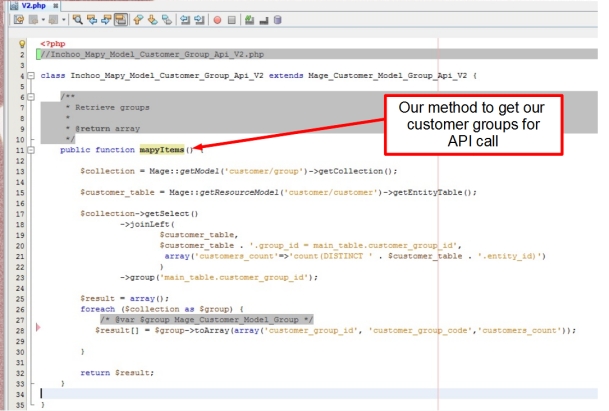- 浏览: 2018546 次
- 来自: 武汉
-

文章分类
- 全部博客 (415)
- UI设计 (19)
- PHP (26)
- PHP工具类 (23)
- 二次开发 (53)
- phpMVC (28)
- javascript (50)
- JS 组件 (20)
- MYSQL (37)
- 其他 (16)
- xml/flash/flex (6)
- 版本控制 (7)
- 开源 (4)
- bug解决 (5)
- Linux (15)
- NoSQL (14)
- 软件设计 (21)
- C/PHP内核 (5)
- 安全性 (8)
- 面试 (18)
- 设计模式 (4)
- 重构 (6)
- 开发配置 (11)
- SQL SERVER (12)
- 采集 (3)
- SEO (2)
- 维护 (15)
- UML (5)
- 硬件标准 (1)
- 架构 (8)
- JAVA (1)
最新评论
-
carry0987:
求大神分離下X3的模板...不然對於PHP7不友好啊...
分离自Discuz模板类和语法 -
青木得海角:
你好,里面的 Crypt/TripleDES.php 和 Cr ...
POS机算法 -
zohog:
楼主,Mac.php中里面的 Crypt/TripleDES. ...
POS机算法 -
zohog:
楼主,Mac.php中里面的 Crypt/TripleDES. ...
POS机算法 -
q59200182:
能不能给个完整的demo 新手上路不会 求带
AngularJs 指令directive之controller,link,compile
http://yourserver.com/api/v2_soap /?wsdl v2是java,.net等语言可调用,可模仿Customer
Basic steps:
1. Create Magento Extension (we are not going explain here how to do it)
2. Create Model for API method
3. Create and configure api.xml file
4. Create wsdl.xml file (with proper definitions)
5. Create wsi.xml file (with proper definitions) (OPTIONAL)
Creating Model for API v2
After properly configuring our config.xml it looks like this:
|
1
2
3
4
5
6
7
8
9
10
11
12
13
14
15
16
|
<?xml version=
"1.0"
?>
<config>
<modules>
<Inchoo_Mapy>
<version>1.0.1</version>
</Inchoo_Mapy>
</modules>
<
global
>
<models>
<inchoo_mapy>
<
class
>Inchoo_Mapy_Model</
class
>
</inchoo_mapy>
</models>
</
global
>
</config>
|
Let’s navigate through Magento core files to see where Magento API models are in file-system:
Since we are going to use API v2 only, We will create our model like this:
Creating and configuring api.xml
The easiest way is to copy/paste one of Magento’s api.xml files in our etc folder and make changes there to suit our needs. Our final api.xml should look like this:
|
1
2
3
4
5
6
7
8
9
10
11
12
13
14
15
16
17
18
19
20
21
22
23
24
25
26
27
28
29
30
31
32
33
|
<?xml version=
"1.0"
?>
<config>
<api>
<resources>
<!-- START GUSTOMER GROUP RESOURCES -->
<mapy_customer_group>
<model>inchoo_mapy/customer_group_api</model>
<title>Inchoo Customer's Groups API</title>
<acl>mapy_data</acl>
<methods>
<list translate=
"title"
module=
"inchoo_mapy"
>
<title>Retrieve customer groups</title>
<method>mapyItems</method>
</list>
</methods>
</mapy_customer_group>
<!--
END
CUSTOMER GROUP RESOURCES -->
</resources>
<v2>
<resources_function_prefix>
<mapy_customer_group>mapy_customerGroup</mapy_customer_group>
</resources_function_prefix>
</v2>
<acl>
<resources>
<mapy_data translate=
"title"
module=
"inchoo_mapy"
>
<title>Mapy data</title>
<sort_order>3</sort_order>
</mapy_data>
</resources>
</acl>
</api>
</config>
|
Here is logic that has to be implemented in api.xml file. Api.xml file basically connects API calls with php methods inside specific models. Also, the ACL resources are defined here for specific api call.
Creating wsdl.xml file
When working with wsdl.xml and wsi.xml later, if you are happy NetBeans user, I strongly suggest you to search on Google and download the XML Tools plug-in that can make life much easier …
There are few things that we have to fill-in when creating wsdl.xml.
- Bindings
- Port types
- Messages
- Types / Complex types
Also, it’s easier to copy one of Magento’s wsdl files, paste it in our etc folder and remove unnecessary things and add our own inside.
Here is NetBeans – XML Tools screen-shot how this look like:
This image is showing logic and direction how should we fill-in wsdl.xml:
Let’s now look at real xml source:
After we finished with wsdl, let’s go to http://ourmagento/api/v2_soap/?wsdl=1 to see changes in global wsdl we made. (Don’t forget to clear cache first! ).
发表评论
-
phpcms v9网站搬家更换域名的方法
2016-06-17 09:39 1476网站在发展的过程中,很可能多次的修改域名。那么在PHPCM ... -
phpcms SEO
2016-06-15 16:33 1308大家应该都是在header头文件里写上{if isset( ... -
Magento 自定义Url
2013-12-12 22:21 1294查看Url重写列表,在后台的Catalog > URL ... -
magento 如何安装模板主题
2013-11-07 23:26 2057注意区分“主题包”和“主题文件”这两个概念。我们所使用的主 ... -
MAGENTO调试时候,关闭缓存
2013-11-07 22:43 3622在调试MAGENTO的时候,我们其实不需要为了每一个小的的 ... -
Magento 返回不带Layout的页面输出
2013-08-06 13:58 8282. 在controller的代码方式创建并输出block ... -
magento 添加 删除css js
2013-06-03 20:41 2521在addJs、addCss的代码一般在page/html_ ... -
Magento Shell
2013-04-16 15:32 1460在magento/shell/下Virtualcard.p ... -
Magento 开启模板路径提示
2013-01-30 17:22 2246Magento 中, 任何一个页面中的 html 代码都来 ... -
Magento 中的事件
2013-01-06 14:19 1282magento的事件机制就跟dural的hook机制一样,为了 ... -
Magento Adminhtml Form
2012-11-29 17:37 1547开发Magento后台的时候经常用到表单(Varien_D ... -
Magento 添加后台管理 addColumn
2012-11-16 17:07 1946复选框 $row->getData($this-& ... -
Magento 覆写
2012-10-16 13:37 1508magento的覆写很重要,在项目开发过程中经常需要修改核心的 ... -
Magento 自动添加属性 自动添加表
2012-09-03 13:43 19221自动添加属性字段 config.xml <r ... -
Magento 临时替代默认店铺
2012-08-22 10:10 1426多店铺主题切换http://hudeyong926.ite ... -
Magento 添加后台管理
2012-07-27 11:13 4308后台菜单显示点击后404,如果adminhtml.xml配 ... -
Magento 如何调用static block
2012-04-19 15:53 1707若想在站点页面的某个地方放点静态的内容,比如广告,或者是促 ... -
Magento 数据库EVA
2012-03-14 16:30 2947实体,属性和值(EVA)数据库架构排在第一,非常难以把握。E ... -
Magento API v1 之webservice
2012-03-09 12:18 3070sales/etc/api.xml <?xml ver ... -
magento model collection
2012-03-09 12:03 4255colleciton的启用 Ticket\Model\L ...

















相关推荐
Magento API 速查(alan storm).pdf
Magento Python API 用于连接到Magento Web服务的Python库。 用法 import magento url = 'http://domain.com/' apiuser = 'user' apipass = 'password' # Create an instance of API client = magento . API ( url ...
Magento API SOAP 一个与Magento集成的Wordpress插件。设定值如何使用! use Magento \ API \ SOAP \ Product ;//Get a single product by id.$ product_model = new Product ( 1 );$ product_model = new Product ...
Magento API REST 一个与Magento REST API一起使用的Node.js客户端包装。安装 npm i magento-api-rest入门按照生成API凭证。 确保检查资源访问是否符合您的要求,以防止滥用API密钥。 查看可以操纵的Magento API端点...
Magento插件源代码,计算商品税的,可以学习参考。
Magento Rest API客户端基于Node.js的客户端与Magento REST Api进行交互。 ##使用指南var magentoRestApi = require('magento-rest-api');// Create api objectvar api = magentoRestApi.createClient({ consumerKey...
通过 Magento API 访问可配置产品。 Magento REST API 和前端有端点。 描述 创建可配置产品,设置其选项和相关产品。 然后通过 Magento API 访问该产品和选项。 促进为您的 Magento 网站上的特定产品创建移动应用...
Magja是Magento SOAP API的Java连接器,可以轻松与流行的商店系统集成,并可以交换Magento API可用的所有数据。 核心功能 对Magento 1.x SOAP API V1的基本支持 允许访问: 产品 产品媒体 产品链接 产品类别 产品...
GoogleShoppingApi, Magento模块 GoogleShoppingApi v2 GoogleShoppingAPI v2 更新到重要 !如果你从早期版本更新到 0.2.4,请注意类别id已经更改。 有一个 shell script 插件,可以帮助你将旧的类别id映射到新的...
Magento.RestApi-异步C#Magento REST API客户端是一个开放源代码电子商务平台,允许外部应用程序通过SOAP API或REST API与之交互。 仅在Magento的1.7版本中可用。... var client = new MagentoApi
额外的RESTful 邀请开发人员在项目中包含此可重用的扩展... (Magento API2错误地在这里重复了最后一页。) ,便于分页。 (这与相似,不同之处在于URI相对于网站的基本URL) 资源变更 新资源 URL重写 CMS块 CMS页面
自述 此自述文件用于构建在 Ruby on Rails 上的 Magento API 包装器,用于将 Rails 应用程序连接到 Magento API 涵盖的内容有: 上市产品列出单个产品信息上市股票数据列出客户上市订单创建/更新产品向产品添加媒体...
magento官方文档翻译超好,真正懂得magneto数据层操作,懂得其数据封装方式,英汉对照更有利于学习
我们基于连接到Magento REST API并验证/授权客户访问产品列表的Android平台创建了此示例。 在此示例应用程序中,我们使用 , , 和为开发人员提供了一个平台,该平台可用于为magento框架开发android移动应用程序。
magento数据结构分析 magento数据字典
Laravel开发-magento 使用SOAP API的简单magento集成
http://www.magentocommerce.com/api/soap/introduction.html作者:本顿·斯奈德网站: : 创建时间:13 年 5 月 19 日修订:3/10/15用法 magento = Magento('http://magento.example.com/api/v2_soap?wsdl=1'...
该模块使用PagSeguro以API形式提供的以下功能: 与集成 与集成 要求 社区2.0.8 | 2.1.0至版本2.1.9 [Magento版本]对于以前的版本,请使用其他标签 5.5以上 安装 强烈建议您在升级生产环境中的存储之前,拥有一个...
magento的SMTP插件magento的SMTP插件magento的SMTP插件
我知道,一旦获得api-user的授予访问权限,它就可以做任何事,这就是为什么在System> Configuration> Magento Core API> Api-ModelBridge中出现警告,以及为什么根本没有此附加配置的原因 何时使用此模块 如果您是...